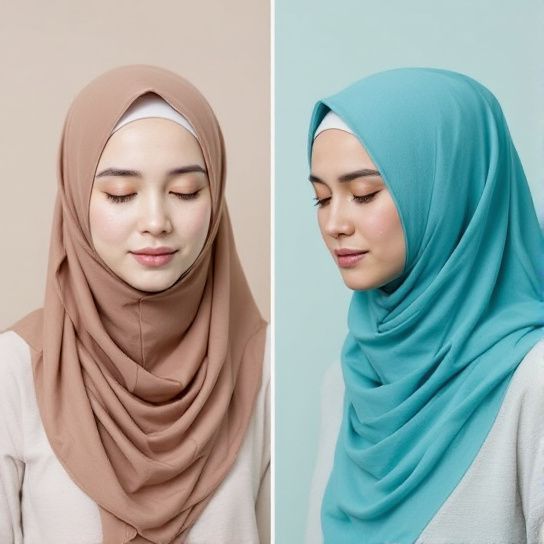Embracing Your Natural Hair Texture Under Hijab

When it comes to maintaining healthy hair and scalp as a hijabi, it’s essential to consider both the religious and cultural aspects that come with wearing a hijab. Wearing a hijab doesn’t mean your hair should suffer; with a tailored hair care routine, you can ensure your locks remain vibrant and healthy underneath.
Key Challenges and Solutions
1. Scalp Health
Extended periods of coverage can lead to sweating and reduced air circulation, which can affect scalp health. To prevent issues like dandruff or itchy scalp:
- Weekly Scalp Treatments: Use a natural oil treatment like argan oil or coconut oil. Massage the oil into your scalp once a week to balance natural oils and provide nourishment.
- Choose Breathable Fabrics: Opt for hijabs made from lightweight, breathable fabrics such as cotton or bamboo. These help improve airflow and reduce sweat accumulation.
- Limit Tight Styles: Tirely pulled back styles can increase tension on the scalp, leading to discomfort and hair breakage over time. Opt for looser, protective styles underneath the hijab.
2. Hair Moisture Retention

Covered hair can lose moisture, leading to dry, brittle strands. To prevent dehydration:
- Hydrating Shampoo and Conditioner: Use sulfate-free products like the **SheaMoisture Manuka Honey & Mafura Oil Intensive Hydration Shampoo and Conditioner. These are free of harsh chemicals and packed with nourishing ingredients.
- Deep Conditioning: Incorporate a deep conditioning treatment every 1-2 weeks. **Ouidad Curl Immersion Triple Treat Deep Conditioner, laden with natural oils and botanicals, is particularly effective at sealing in moisture and enhancing natural hair texture.
3. Hair Breakage and Thinning

Daily hijab wear can cause friction, leading to hair breakage. To mitigate this:
- Silk or Satin Bonnet: Wear a silk or satin cap under your hijab to minimize the friction between your hair and the scarf fabric. These materials help reduce hair stress and preserve moisture.
- Biotin Supplements: Consider incorporating a high-quality biotin supplement to strengthen hair from within. Always consult with a healthcare provider before starting.
4. Daily Routine and Maintenance
Establishing a routine that respects your personal and religious time constraints while still caring for your hair is crucial.
- Morning: Start with a gentle detangling using a wide-tooth comb or a detangling brush. Apply a leave-in conditioner to retain moisture.
- Nightly Routine: Wrap hair in a silk scarf or use a satin pillowcase to prevent overnight friction and tangling.
Product Recommendations

- Leave-in Conditioner: **Kinky-Curly Knot Today Leave-In Conditioner, excellent for daily use, promoting easy detangling and moisturization.
- Anti-Dandruff Solution: For scalp irritation, try **Nizoral Anti-Dandruff Shampoo, which contains ketoconazole, effective in controlling the chemical that causes dandruff.
Conclusion
Balancing the needs of your hair with the requirements and beauty of hijab-wearing is entirely achievable with careful selection of treatments and products. By aligning traditional practices with science-based solutions, you ensure your hair remains a source of beauty and confidence, even when covered. Always remain open to adjusting your routine to suit the specific needs of your hair type and environment, honoring both your cultural values and personal health goals.
Frequently Asked Questions
What are the common challenges faced by hijabi women with natural hair?
Hijabi women with natural hair often face challenges such as thinning, receding, dryness, and frizziness due to constant coverage and the use of potentially damaging fabrics. Additionally, they may struggle with avoiding the “camel hump” appearance, managing bumpy braids under the hijab, and finding cute and protective styles[2][4].
What are some protective hairstyles suitable for natural hair under a hijab?
Protective hairstyles such as flat twists, single twists, braids, and locs are highly recommended. These styles protect the ends of the hair, lock in moisture, and reduce tension on the scalp. Locs, in particular, are low maintenance and versatile, although they may collect lint and have a longer drying time after ghusl[2][3][5].
How can hijabi women prevent lint and reduce drying time for locs under the hijab?
To prevent locs from picking up lint, wear a satin or silk fabric against your locs. For faster drying after ghusl, lightly blow dry your hair on low heat until it is about 80% dry, then air dry the rest to avoid heat damage[2].
What tips can help hijabi women maintain healthy natural hair while wearing a hijab?
Key tips include using gentle, sulfate-free products, deep conditioning regularly, and avoiding excessive heat. It is also important to keep hairstyles that do not pull too tightly on the hair and to use satin or silk underscarves to reduce friction and prevent hair damage[1][3][4].
References- Hijabi Natural Hair Care: How I Regained Pride & My Go…
- 6 Beautiful & Protective Hairstyles (Plus Crucial Tips!) for Textured Hair to Wear Under the Hijab
- How to Maintain Healthy Natural Hair Under Your Scarf
- My Natural Hair Journey as a Hijab-Wearer Led to a Thriving Business
- Caring for Natural Hair While Wearing Hijab – an Interview with IG’s 4c_hijabi







